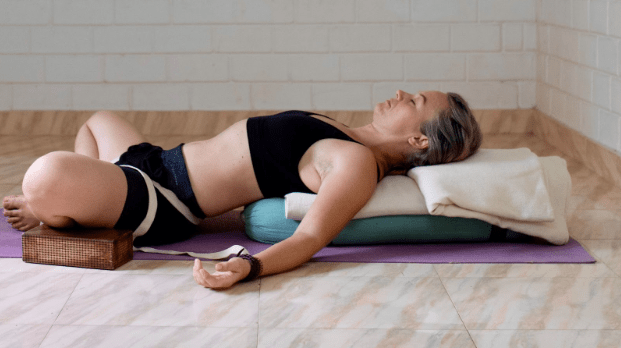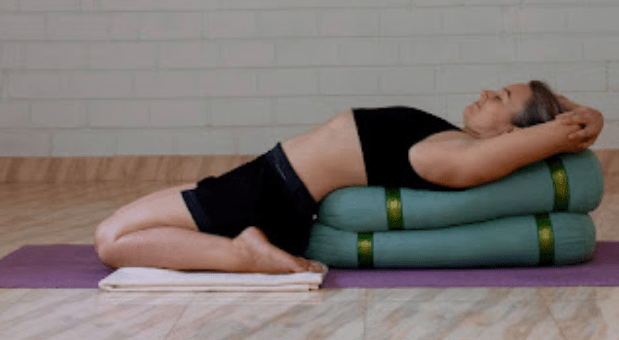What is Restorative Yoga:
Restorative Yoga is a gentle, relaxing yoga, practised at a slow pace. It focuses on deep breathing, relaxation and well-being. It reduces stress, enhances sleep, and rejuvenates the body. Restorative Yoga is different from the more active forms of yoga. It teaches the art of stillness while using support. It encourages the use of props to aid in the holding of yoga poses for longer durations. This allows the body to open more through passive stretching.
Its gentle and soothing nature makes it very accessible to all categories of yoga practitioners and can be adapted to suit their individual needs.
Restorative Yoga is usually practised in complete silence. This makes it a highly reflective experience.
During practice one has to close one’s eyes and draw one’s awareness inward while simultaneously surrendering yourself to a deep state of relaxation.Restorative Yoga is a gentle, relaxing yoga, practised at a slow pace. It focuses on deep breathing, relaxation and well-being. It reduces stress, enhances sleep, and rejuvenates the body. Restorative Yoga is different from the more active forms of yoga. It teaches the art of stillness while using support. It encourages the use of props to aid in the holding of yoga poses for longer durations. This allows the body to open more through passive stretching.

What is the Origin of Restorative Yoga?
Restorative Yoga is a fairly new trend and originated from the work of B. K. S. Iyengar. Iyengar yoga is a very physically demanding yoga with a strict schedule. The guru realized that his students needed a break between his hectic yoga sessions to restore and rejuvenate their bodies. He started introducing brief sessions of yoga using gentle, calming asanas in between the more demanding ones. Iyengar yoga is a style which uses props to enhance the flexibility and strength of the practitioner. So he started using props to help support the body during these restorative poses to offer a deeper level of relaxation. Soon this style of yoga was adopted by more and more teachers in their yoga classes. Now it has become an essential part of yoga studio curriculums.
Different teachers have evolved their own unique styles of teaching this soothing and relaxing yoga. However, the core principles remain the same, they all use relaxing physical postures, pranayama and meditation techniques that help the practitioner calm the mind and soothe the body. Restorative Yoga works on the body at both the physical and the physiological levels.
Pillars of Restorative Yoga
1. Physical: The focus of this pillar is to relax and rejuvenate the physical body of the yoga practitioner. The use of gentle poses, along with the use of props aids in relaxing the body and making it more flexible.
2. Mental: This pillar works on using focused breathing exercises and meditation techniques. This results in helping the mind to stay calm, be at peace with itself, and attain clarity.
3. Emotional: The third pillar helps nurture the yoga practitioner’s emotional well-being. Restorative Yoga’s soothing relaxing nature facilitates emotional release and stability.
Whether you want to practice or teach Restorative Yoga, getting familiar with these three core pillars is very important.
Why You Need to Practice Restorative Yoga
● You find it difficult to fall asleep at night.
● You feel fatigued when you wake up in the morning.
● Your mind is chaotic even when you are resting.
● You feel sharp pain shooting up your body on any sudden movement.
● You feel angry and irritated all the time.
5 Key Practices Taught in Restorative Yoga
1. Pranayama and Meditation
2. Basic Asanas
3. Props

4. Long Holds
5. Deep Rests
5 Best Restorative Yoga Poses For Beginners
1. Child pose – Balasana: To make this pose more comfortable grab a bolster and place it between your knees in a sitting position. Now bend forward into the prop until your face touches the bolster. Relax and try to hold this position for at least 7 minutes.
2. Seated Cat Cow – Upavistha Bitilasana Marjaryasana: This pose is practised in most yoga styles and helps to move the spine in all directions. This cross-legged, seated pose involves breathing techniques of inhalation and exhalation. The seated version of the cat and cow pose is very gentle and opens up the body.
3. Supported Bridge Pose – Setu Bandha Sarvangasana: Lie on your back with your knees bent and your legs hip-width apart. You can do this pose with the help of a yoga block for more stability. Hold this pose for 3 – 5 minutes. Belly breathe throughout.
4. Sleeping Forward Fold – Pashcimottasana: Sit on the edge of a bolster in a staff pose extend your legs out in the front and keep your back straight. Bend at the hips until your tummy touches the bolster. Breathe deeply and hold the pose for 5 – 10 minutes.
5. Supported Fish Pose – Matsyasana: Grab a bolster and sit on the mat with legs stretched out in the front. Place the bolster behind you until it is just touching your lower back. Gently lean back into the bolster with your arms dropping at your sides and your palms facing upwards. You can stay in this relaxing pose for as long as you like.
As a beginner to Restorative Yoga, you will find that one session is usually made up of 5 to 6 gentle poses. These poses are supported by props that ease you into the pose and help you to sustain it for a length of time.

Benefits of Restorative Yoga
Sequencing of Restorative Yoga
How Restorative Yoga Helps One to Develop an Attitude of Gratitude
Restorative Yoga is the best practice if you are looking to tap into your gratitude space. The long holds and relaxing poses help you to become relaxed. The poses help you to comfort your body and the props used to support the asanas, allow you to stay in them for a length of time, almost 7 minutes. Restorative Yoga creates an enriching environment for the development of gratitude consciousness. Some of the ways the practice of Restorative Yoga helps are:
Conclusion
By practising Restorative Yoga, you are creating a slow and gentle sequence that teaches your body to rest safely. It is highly accessible and adaptable to an individual’s needs and is generally considered safe for most people to use. It is soothing and relaxing for the nervous system and is thus beneficial to the whole body.
A continuous and intentional practice of Restorative Yoga reduces stress and anxiety, regulates heart rate and blood pressure, and aids digestion, along with other benefits. Take the time to indulge in the practice of this form of yoga and take advantage of all the benefits it offers.
Interested in becoming a yoga teacher?
